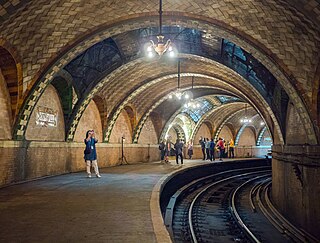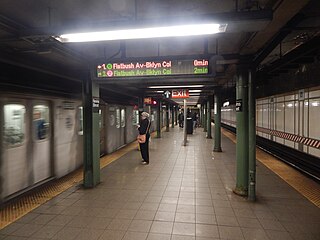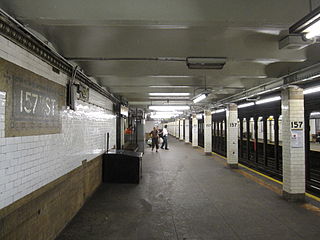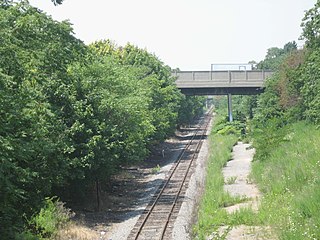This is a list of manhole cover markings found in New York City .

This is a list of manhole cover markings found in New York City .


The Dual Contracts, also known as the Dual Subway System, were contracts for the construction and/or rehabilitation and operation of rapid transit lines in the City of New York. The contracts were signed on March 19, 1913, by the Interborough Rapid Transit Company and the Brooklyn Rapid Transit Company. As part of the Dual Contracts, the IRT and BRT would build or upgrade several subway lines in New York City, then operate them for 49 years.

The Interborough Rapid Transit Company (IRT) was the private operator of New York City's original underground subway line that opened in 1904, as well as earlier elevated railways and additional rapid transit lines in New York City. The IRT was purchased by the city on June 12, 1940, along with the younger BMT and IND systems, to form the modern New York City Subway. The former IRT lines are now the A Division or IRT Division of the Subway.

The Brooklyn Rapid Transit Company (BRT) was a public transit holding company formed in 1896 to acquire and consolidate railway lines in Brooklyn and Queens, New York City, United States. It was a prominent corporation and industry leader using the single-letter symbol B on the New York Stock Exchange.

The City Hall station, also known as City Hall Loop station, is a closed station on the IRT Lexington Avenue Line of the New York City Subway. It is located under City Hall Park, next to New York City Hall, in the Civic Center neighborhood of Manhattan in New York City. The station was constructed for the Interborough Rapid Transit Company (IRT) as the southern terminal of the city's first subway line, which was approved in 1900. Construction of the segment of the line that includes the City Hall station started on September 12 of the same year. The station opened on October 27, 1904, as one of the original 28 stations of the New York City Subway. As ridership grew, it was deemed infeasible to lengthen the original platform to accommodate ten-car trains. The station was closed on December 31, 1945, because of its proximity to the Brooklyn Bridge station.

The Nevins Street station is an express station on the IRT Eastern Parkway Line of the New York City Subway. Located at the intersection of Nevins Street, Flatbush Avenue, and Fulton Street in Downtown Brooklyn, it is served by the 2 and 4 trains at all times, the 3 train all times except late nights, and the 5 train on weekdays only.

The 61st Street–Woodside station is an express station on the IRT Flushing Line of the New York City Subway located at 61st Street and Roosevelt Avenue in Woodside, Queens. It is served by the 7 train, with additional peak-direction <7> service during rush hours.

The 82nd Street–Jackson Heights station is a local station on the IRT Flushing Line of the New York City Subway, located at the intersection of 82nd Street and Roosevelt Avenue in Jackson Heights, Queens. It is served by the 7 train at all times.

New York City Subway nomenclature is the terminology used in the New York City Subway system as derived from railroading practice, historical origins of the system, and engineering, publicity, and legal usage. Important terms include lines, or individual sections of subway, like the BMT Brighton Line; services, like the B, which is a single train route along several lines; and stations, such as Coney Island–Stillwell Avenue, which connects multiple lines and services.
Starting in 1899, the Brooklyn Rapid Transit Company and Brooklyn–Manhattan Transit Corporation operated rapid transit lines in New York City — at first only elevated railways and later also subways.

The 157th Street station is a local station on the IRT Broadway–Seventh Avenue Line of the New York City Subway. Located at the intersection of Broadway and 157th Street in Washington Heights neighborhood of Manhattan, it is served by the 1 train at all times.

The Chambers Street station is an express station on the IRT Broadway–Seventh Avenue Line of the New York City Subway, located at the intersection of Chambers Street and West Broadway in the TriBeCa and the Financial District neighborhoods of Manhattan, it is served by the 1 and 2 trains at all times, and by the 3 train at all times except late nights.

The Astoria Boulevard station is an express station on the BMT Astoria Line of the New York City Subway. Located on 31st Street between Astoria Boulevard and the Grand Central Parkway in Astoria, Queens, the station is served by the N train at all times, as well as by the W train on weekdays.

The Bay Ridge Branch is a rail line owned by the Long Island Rail Road (LIRR) and operated by the New York and Atlantic Railway in New York City. It is the longest freight-only line of the LIRR, connecting the Montauk Branch and CSX Transportation's Fremont Secondary at Glendale, Queens with the Upper New York Bay at Bay Ridge, Brooklyn.
The New York City Subway's B Division consists of the lines that operate with lettered services, as well as the Franklin Avenue and Rockaway Park Shuttles. These lines and services were operated by the Brooklyn–Manhattan Transit Corporation (BMT) and city-owned Independent Subway System (IND) before the 1940 city takeover of the BMT. B Division rolling stock is wider, longer, and heavier than those of the A Division, measuring 10 or 9.75 ft by 60 or 75 ft.
The Manhattan Railway Company was an elevated railway company in Manhattan and the Bronx, New York City, United States. It operated four lines: the Second Avenue Line, Third Avenue Line, Sixth Avenue Line, and Ninth Avenue Line.

The IRT Powerhouse, also known as the Interborough Rapid Transit Company Powerhouse, is a former power station of the Interborough Rapid Transit Company (IRT), which operated the New York City Subway's first line. The building fills a block bounded by 58th Street, 59th Street, Eleventh Avenue, and Twelfth Avenue in the Hell's Kitchen and Riverside South neighborhoods of Manhattan.
The IRT New Lots Line or Livonia Avenue Line is a rapid transit line in the A Division of the New York City Subway. Located in the New York City borough of Brooklyn, the line runs from the Crown Heights–Utica Avenue station in Crown Heights and continues to the New Lots Avenue station in East New York.